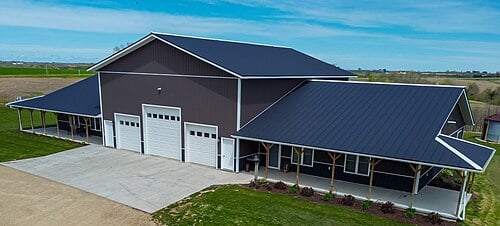
The latest American housing trend is saddling up for Australia, and it's got more substance than your average cultural import.
While we've seen everything from pickup trucks to pumpkin spice lattes cross the Pacific, the barndominium movement represents something different—a genuine response to housing challenges that might just make sense on our shores.
Luke Fryer, former general manager of Australia's biggest home builder Metricon, isn't just chasing the latest fad. His startup Longhorn Group wants to bring these ranch-style steel-framed homes—complete with soaring ceilings and rustic charm—to locations 'everywhere from Darwin to Launceston and over to Broome.'
What exactly is a barndominium?
A barndominium, also known as a barndo, is a metal pole barn, post-frame or barn-like structure with sheet metal siding that has been partially or fully converted into a furnished home or living area.
Think of it as a large, barnlike structure that's divided in half, with a residence on the upper levels and some type of workstation, garage, or other multipurpose area on the ground level.
The concept isn't entirely new—the term was originally coined by Karl Nilsen, a real estate developer in Connecticut, combining the words barn and condominium.
But the modern barndominium boom really took off after Chip and Joanna Gaines featured one on HGTV's Fixer Upper in 2016, causing a massive surge in popularity and growing acceptance.
The surge in attention and demand, especially evident in 2020, shows no signs of slowing down. They're an increasingly popular option for single-family homes, particularly in rural markets away from the coasts — Texas, Tennessee and Montana are especially popular locations.
'We're going to design and build these things everywhere from Darwin to Launceston and over to Broome'
The Australian vision
Fryer's 'Barndominiums' aren't your average kit homes. With their modern style, open floor plans, and affordability, his 12 designs sport names like the Oklahoma, Wyoming, and Minnesota. These aren't just American names slapped on Aussie buildings—they're designed for our climate and countryside.
The homes feature eight to 12-metre high ceilings, large stone fireplaces, and floor-to-ceiling windows perfect for taking in Australia's rugged landscapes. As Fryer told Yahoo News, he sees these spaces as ideal for locations where 'a farmer on his four-wheeler might stop for 20 seconds and admire the view.'
Sized between 450 to 730 square metres, they're designed for rural and regional areas with completely off-grid capabilities—power supply, water storage, and sewage treatment included. The price range spans $700,000 for basic models up to $2.3 million fully loaded, which Fryer claims will be 10 per cent cheaper than comparable traditional homes.
The American success story
The numbers from across the Pacific are compelling. Building a barndominium costs about $62-136 per square foot compared to traditional home builds at $100-150 per square foot. While building a standard home takes an average of eight months, barndominiums generally take around six months.
In Texas, Fryer witnessed homes going up in just 150 days—something he describes as 'mindblowing' compared to the 10-11 months typical in Australia. While he doesn't expect to match American speeds due to our trade shortages, he's confident of achieving six-month build times through dedicated on-site teams.
Why barndominiums are booming in America
- 30-40 per cent lower cost per square foot than traditional homes
- 25 per cent faster construction times
- Superior durability against extreme weather
- Lower maintenance requirements
- Highly customisable open-plan designs
- Growing acceptance from lenders and insurers
The practical reality for Australians
Before you start planning your rural retreat, there are some important considerations that American buyers have learned the hard way.
Financing challenges
Obtaining a mortgage can be more difficult than usual, as lenders are uncertain how to determine the value of non-traditional homes. This is something Australian buyers will need to navigate carefully, particularly as our lending standards are already quite conservative.
Zoning and location restrictions
Barndominiums are often not allowed in cities and towns due to building regulations. They are more common to find in rural areas where the building code is more relaxed. This aligns with Fryer's rural focus, but it means these homes won't suit everyone's lifestyle preferences.
Market considerations
Since they are a niche market with a floor plan that is customized to each owner's specifications, it may be difficult to sell in the future. However, barndominiums appreciate at about the same rate as commercial properties (about two to three percent per year in a regular market), and they generally do not depreciate in value.
What to consider before building a barndominium in Australia
Check local council zoning laws and building regulations
Discuss financing options with your bank early in the process
Consider resale potential in your specific area
Factor in utility connections for rural locations
Evaluate ongoing maintenance capabilities
Assess suitability for your long-term housing needs
Why this might appeal to Australian seniors
For those over 60 considering their housing options, barndominiums offer several compelling advantages that align well with changing lifestyle needs.
Maintenance benefits
Their metal or steel shells help make them resistant to mould, rot, and the elements—more so than a traditional home! Not only do you get peace of mind knowing your home is more protected, but you can also keep insurance costs low. Steel is much easier to maintain than alternatives used in traditional home projects, with a side effect being cheaper insurance as well.
Design flexibility
Many post-frame buildings do not require interior load-bearing walls, allowing you to design the layout of your home exactly the way you want it without being restricted by interior walls. This could be particularly valuable for creating accessible, single-level living spaces or accommodating mobility aids as needs change.
Energy efficiency
New models can be designed to be energy-efficient by sealing the building, installing double-pane windows and spraying foam insulation. Combined with Fryer's promise of sustainable features including recycled timber and commercial-grade ventilation systems, ongoing utility costs could be significantly lower than traditional homes.
The innovation argument
Fryer makes a pointed observation about Australian housing: building methods haven't fundamentally changed since the 1980s. While Europe embraces prefabrication and America benefits from abundant labour, Australia seems stuck in traditional approaches.
His criticism extends to design innovation too. Google Trends data indicates a steady rise in interest in barndominiums, notably boosted by their portrayal on HGTV. The global interest suggests there's genuine appetite for housing alternatives.
As more people rebuild from natural disasters, they are educating themselves on the strength and durability of steel frames, with these rustic-chic types of homes gaining popularity due to their affordability, speedy construction, and resistance to natural disasters.
The bigger housing picture
Whether or not Fryer's barndominium vision takes hold, his critique of Australian housing innovation deserves attention. With housing affordability at crisis levels and construction delays plaguing the industry, alternative approaches merit serious consideration.
With uncertainty surrounding the US housing market, including record high prices and low inventory, many consumers are seeking out alternative living options. One option more people are turning to is the barndominium.
The off-grid capabilities of these homes also align with growing interest in sustainable, self-sufficient living—particularly relevant as more Australians consider rural retirement options or seek to reduce their environmental footprint.
Of course, there's the inevitable cultural resistance to American influences. But as Fryer points out, 'Australia has a long history of taking its pop culture, fashion, and architectural cues from the States.'
Did you know?
Did you know?
The barndominium trend has spread beyond America to Canada, Australia, and the United Kingdom, with modular versions available that can reduce build times by 20-30 per cent compared to traditional construction while maintaining quality control through factory construction methods.
What this means for you
Before getting swept up in barndominium enthusiasm, consider whether this housing style truly fits your needs. The rural location requirement means you'll need to be comfortable with country living, potentially including septic systems, bore water, and limited access to services.
The financing challenges are real, so early discussions with lenders are essential. The customisation possibilities are exciting, but remember that highly personalised homes can be harder to sell.
For those already considering rural retirement or seeking a low-maintenance lifestyle, barndominiums offer genuine advantages. The combination of durability, energy efficiency, and design flexibility could make them an attractive option for seniors wanting to simplify without sacrificing comfort.
Whether Fryer's vision of barndominiums 'everywhere from Darwin to Launceston' becomes reality remains to be seen. But in a housing market crying out for innovation and affordability, it's refreshing to see someone willing to challenge the status quo.
What are your thoughts on bringing American-style barndominiums to Australia? Would you consider this housing style for your next home, or do you think we should stick with tried and tested Australian building methods?
Original Article
https://au.news.yahoo.com/radical-p...-build-these-things-everywhere-033242860.html
Barndominium—Wikipedia
Cited text: A barndominium, also known as a barndo, is a metal pole barn, post-frame or barn-like structure with sheet metal siding that has been partially or ful...
Excerpt: A barndominium, also known as a barndo, is a metal pole barn, post-frame or barn-like structure with sheet metal siding that has been partially or fully converted into a furnished home or living area.
https://en.wikipedia.org/wiki/Barndominium
Barndominiums Are Coming to a Neighborhood Near You
Cited text: The word barndominium is (as you might suspect) a combination of the words “barn” and “condominium,” and it’s typically defined as a large, barnlike s...
Excerpt: a large, barnlike structure that's divided in half, with a residence on the upper levels and some type of workstation, garage, or other multipurpose area on the ground level.
https://www.housebeautiful.com/design-inspiration/a63655776/what-is-a-barndominium-guide/
Barndominium—Wikipedia
Cited text: The term barndominium was originally coined by Karl Nilsen, who was a real estate developer in Connecticut. Barndominium is derived from using a combi...
Excerpt: the term was originally coined by Karl Nilsen, a real estate developer in Connecticut, combining the words barn and condominium.
https://en.wikipedia.org/wiki/Barndominium
Barndominium—Wikipedia
Cited text: In 2016, Chip and Joanna Gaines of the HGTV show Fixer Upper used the term barndominium to refer to a metal building that was featured on the show. Th...
Excerpt: Chip and Joanna Gaines featured one on HGTV's Fixer Upper in 2016, causing a massive surge in popularity and growing acceptance.
https://en.wikipedia.org/wiki/Barndominium
Barndominium—Wikipedia
Cited text: The surge in attention and demand, especially evident in 2020, shows no signs of slowing down.
Excerpt: The surge in attention and demand, especially evident in 2020, shows no signs of slowing down.
https://en.wikipedia.org/wiki/Barndominium
What Is A Barndominium? | Bankrate
Cited text: They’re an increasingly popular option for single-family homes, particularly in rural markets away from the coasts — Texas, Tennessee and Montana are ...
Excerpt: They're an increasingly popular option for single-family homes, particularly in rural markets away from the coasts — Texas, Tennessee and Montana are especially popular locations.
https://www.bankrate.com/real-estate/what-is-a-barndominium/
What is a Barndominium? Inside the ‘Barndo’ Home Trend
Cited text: Barndominiums are known for their modern style, open floor plans, and affordability.
Excerpt: their modern style, open floor plans, and affordability,
https://urbanacres.com/blog/barndominium-home-trend/
The Beginner's Guide to Barndominium Homes | Extra Space Storage
Cited text: In general, building a barndominium will cost about $62-$136 per square foot. Compare that to a traditional home build at $100-$150 per square foot, a...
Excerpt: Building a barndominium costs about $62-136 per square foot compared to traditional home builds at $100-150 per square foot.
https://www.extraspace.com/blog/moving/your-complete-guide-to-barndominiums/
What is a Barndominium? Inside the ‘Barndo’ Home Trend
Cited text: From start to finish, building a standard home on a stud frame takes an average of eight months. When building a barndominium, that timeline is genera...
Excerpt: While building a standard home takes an average of eight months, barndominiums generally take around six months.
https://urbanacres.com/blog/barndominium-home-trend/
Barndominium—Wikipedia
Cited text: Obtaining a mortgage can be more difficult than usual, as lenders are uncertain how to determine the value of non-traditional homes.
Excerpt: Obtaining a mortgage can be more difficult than usual, as lenders are uncertain how to determine the value of non-traditional homes.
https://en.wikipedia.org/wiki/Barndominium
What Is A Barndominium? Pros, Cons, And Cost
Cited text: · Finding a location to build your metal barndominium can be difficult. Barndominiums are often not allowed in cities and towns due to building regula...
Excerpt: Barndominiums are often not allowed in cities and towns due to building regulations.
https://www.westernstatesmetalroofing.com/blog/barndominium
What Is A Barndominium? Pros, Cons, And Cost
Cited text: A barndominium is not a conventional home, so while they are gaining popularity, they do not appeal to the mass market. Since they are a niche market ...
Excerpt: Since they are a niche market with a floor plan that is customized to each owner's specifications, it may be difficult to sell in the future.
https://www.westernstatesmetalroofing.com/blog/barndominium
What is a Barndominium? Inside the ‘Barndo’ Home Trend
Cited text: In fact, barndos appreciate at about the same rate as commercial properties (about two to three percent per year in a regular market), and they genera...
Excerpt: barndominiums appreciate at about the same rate as commercial properties (about two to three percent per year in a regular market), and they generally do not depreciate in value.
https://urbanacres.com/blog/barndominium-home-trend/
The Beginner's Guide to Barndominium Homes | Extra Space Storage
Cited text: Their metal or steel shells help make them resistant to mold, rot, and the elements—more so than a traditional home! Not only do you get peace of mind...
Excerpt: Their metal or steel shells help make them resistant to mould, rot, and the elements—more so than a traditional home!
https://www.extraspace.com/blog/moving/your-complete-guide-to-barndominiums/
What Is A Barndominium? | Bankrate
Cited text: It also cuts down on maintenance costs, as steel is much easier to maintain than the alternatives that are used in more traditional home projects. A s...
Excerpt: Steel is much easier to maintain than alternatives used in traditional home projects, with a side effect being cheaper insurance as well.
https://www.bankrate.com/real-estate/what-is-a-barndominium/
What is a Barndominium? - Cleary Building Corp.
Cited text: Here are a few pros to building a barndominium: Open Interior—Depending on the size of your building, many post-frame buildings do not require inter...
Excerpt: Many post-frame buildings do not require interior load-bearing walls, allowing you to design the layout of your home exactly the way you want it without being restricted by interior walls.
https://clearybuilding.com/news/what-is-a-barndominium/
What is a Barndominium? - Cleary Building Corp.
Cited text: Design Flexibility—Barndominiums allow you to design the layout of your home exactly the way you want it without being restricted by interior walls....
Excerpt: Many post-frame buildings do not require interior load-bearing walls, allowing you to design the layout of your home exactly the way you want it without being restricted by interior walls.
https://clearybuilding.com/news/what-is-a-barndominium/
What Is A Barndominium? | Bankrate
Cited text: “New models can also be designed to be energy-efficient by sealing the building, installing double-pane windows and spraying foam insulation,” Lahey s...
Excerpt: New models can be designed to be energy-efficient by sealing the building, installing double-pane windows and spraying foam insulation.
https://www.bankrate.com/real-estate/what-is-a-barndominium/
Barndominium—Wikipedia
Cited text: Indeed, Google Trends data indicates a steady rise in interest in barndominiums, notably boosted by their portrayal on HGTV (Home & Garden Television)...
Excerpt: Google Trends data indicates a steady rise in interest in barndominiums, notably boosted by their portrayal on HGTV.
https://en.wikipedia.org/wiki/Barndominium
Barndominiums Are Coming to a Neighborhood Near You
Cited text: “As more people rebuild from natural disasters, they are educating themselves on the strength and durability of steel frames,” Hart explains.Now, thes...
Excerpt: As more people rebuild from natural disasters, they are educating themselves on the strength and durability of steel frames, with these rustic-chic types of homes gaining popularity due to their affordability, speedy construction, and…
https://www.housebeautiful.com/design-inspiration/a63655776/what-is-a-barndominium-guide/
What Is A Barndominium? Pros, Cons, And Cost
Cited text: ... With uncertainty surrounding the US housing market, including record high prices and low inventory, many consumers are seeking out alternative liv...
Excerpt: With uncertainty surrounding the US housing market, including record high prices and low inventory, many consumers are seeking out alternative living options.
https://www.westernstatesmetalroofing.com/blog/barndominium






